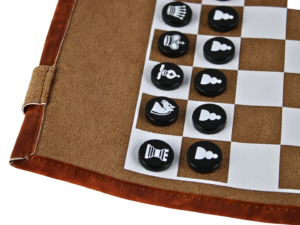
Alekhine Defense: Four Pawns Attack

Overview of the Alekhine Defense
Introduction to the Four Pawns Attack
Main Ideas and Strategies behind the Four Pawns Attack
Key Moves and Variations in the Four Pawns Attack
Pros and Cons of Playing the Four Pawns Attack
How to Handle the Four Pawns Attack as Black?
Notable Games and Players Using the Four Pawns Attack
Overview of the Alekhine Defense
Have you ever heard of the Alekhine Defense? If you’re a chess enthusiast looking to expand your repertoire, this opening might just be what you’re looking for. Named after the fourth World Chess Champion Alexander Alekhine, this defense is characterized by Black allowing White to occupy the center with pawns, only to later launch a counterattack to undermine White’s position.
When playing as Black, the Alekhine Defense begins with the moves 1.e4 Nf6. By placing the knight on f6 early in the game, Black aims to provoke White into overextending their pawn presence in the center, creating potential weaknesses that can be exploited later on.
One of the key features of the Alekhine Defense is its flexibility and dynamic nature. Unlike some other defenses where Black adopts a more passive role, in the Alekhine Defense, Black seeks to disrupt White’s plans and create imbalances on the board. This can lead to rich and complex positions, where tactical skill and strategic understanding play a key role in determining the outcome of the game.
As with any opening, it is essential to familiarize yourself with the main ideas and plans associated with the Alekhine Defense. Understanding the typical pawn structures, piece placement, and potential pawn breaks can give you a strategic edge over your opponent. Additionally, studying master games where the Alekhine Defense is employed can provide valuable insights into the nuances of this opening
Introduction to the Four Pawns Attack
So you’ve decided to play the Alekhine Defense as Black in your chess games – great choice! This dynamic and aggressive opening is known for its sharp tactics and unbalancing potential. And if you’re feeling particularly bold, you might want to consider playing the Four Pawns Attack as White.
The Four Pawns Attack is a bold and ambitious strategy where White pushes their pawns aggressively in the center of the board. This setup aims to control the center and create a strong pawn phalanx that can advance and put pressure on Black’s position. It is a double-edged line that can lead to sharp tactical battles and complex positions.
One of the key features of the Four Pawns Attack is the pawn structure it creates. With pawns on d4, e4, f4, and g4, White secures a strong central presence while also limiting Black’s counterplay. The pawn chain can act as a powerful battering ram, pushing forward to attack Black’s king or creating weaknesses in their position.
Moreover, the Four Pawns Attack is a flexible system that can lead to various pawn structures and piece placements depending on Black’s responses. It can transpose into different variations of the Alekhine Defense, giving White the opportunity to adapt to their opponent’s play and create imbalances on the board.
When playing the Four Pawns Attack, it is crucial to maintain the initiative and keep up the pressure on Black
Main Ideas and Strategies behind the Four Pawns Attack
So, you’ve decided to play the Four Pawns Attack in the Alekhine Defense. Congratulations, you’re stepping into a dynamic and aggressive line of play! But before you dive in, let’s break down the main ideas and strategies behind this exciting opening.
1. **Central Control:** The Four Pawns Attack is all about seizing control of the center with your pawns. By pushing your e and d pawns forward, you aim to build a strong pawn chain that restricts your opponent’s pieces and creates opportunities for your own pieces to maneuver effectively.
2. **Pawn Storm:** One of the key concepts in the Four Pawns Attack is launching a pawn storm on the kingside. By pushing your f and g pawns up the board, you can create threats against your opponent’s king and create weaknesses in their pawn structure. This aggressive approach often leads to tactical complications and can catch your opponent off guard.
3. **Development:** While pushing your pawns forward is important, don’t forget about developing your pieces. Make sure to bring your knights and bishops into the game, castle your king to safety, and connect your rooks. A well-coordinated piece setup is crucial for launching successful attacks and defending against counterplay.
4. **King Safety:** Despite its aggressive nature, the Four Pawns Attack leaves your own king slightly exposed. Be mindful of potential threats against your king,
Key Moves and Variations in the Four Pawns Attack
Are you ready to dive into the exciting world of the Four Pawns Attack in the Alekhine Defense? This sharp opening variation is sure to keep your opponent on their toes and provide you with plenty of opportunities for aggressive play. Let’s take a closer look at some key moves and variations in this dynamic opening.
One of the critical moves in the Four Pawns Attack is 4. f4, where White pushes their f-pawn forward to strike at Black’s e5 pawn. This move is a central part of White’s strategy to control the center and launch a powerful pawn storm on the kingside. By advancing the f-pawn, White aims to create threats against Black’s position and seize the initiative early in the game.
After 4. f4, Black has several options to consider. One common response is for Black to play 4…dxe4, capturing the pawn on e4 and accepting the gambit. This move allows White to continue with their aggressive pawn push with moves like 5. fxe5 or 5. dxe5, maintaining the pressure on Black’s position.
Another possible continuation for Black is to play 4…exf4, opening up the f-file for their pieces and preparing to counterattack against White’s pawn center. This move leads to dynamic and double-edged positions, where both players have chances for active play.
As
Pros and Cons of Playing the Four Pawns Attack
So, you’re considering playing the Four Pawns Attack in the Alekhine Defense. That’s a bold and aggressive choice! Before you dive in, let’s weigh the pros and cons to see if this strategy is the right fit for your playing style.
**Pros:**
1. **Aggressive Play:** The Four Pawns Attack is known for its aggressive nature. By pushing your pawns quickly in the center and launching an early attack, you can put pressure on your opponent right from the start.
2. **Surprise Element:** Many players are not as familiar with the Four Pawns Attack compared to other lines in the Alekhine Defense. This can catch your opponent off guard and give you a psychological edge.
3. **Imbalance:** This line often leads to unbalanced positions where both sides have opportunities for attack. If you enjoy dynamic play and sharp tactical battles, the Four Pawns Attack might be right up your alley.
4. **Development:** By advancing your pawns in the center, you can potentially create more open lines for your pieces to develop rapidly. This can lead to a quicker mobilization of your forces and put your opponent on the defensive.
**Cons:**
1. **Weakness in Pawn Structure:** Pushing your pawns aggressively can weaken the pawn structure around your king. This can leave you vulnerable to attacks and create holes that your opponent can exploit in
How to Handle the Four Pawns Attack as Black
So, you’re facing the Four Pawns Attack as Black in the Alekhine Defense? Don’t panic! While this aggressive opening can be intimidating, with the right strategy and knowledge, you can navigate through it successfully. Here are some tips on how to handle the Four Pawns Attack:
1. Control the Center
One of the key principles in chess is to control the center of the board. In the Four Pawns Attack, White is overextending with four pawn moves on the kingside, leaving the center more vulnerable. As Black, focus on occupying and controlling the central squares to limit White’s offensive options.
2. Develop Your Pieces
Developing your pieces efficiently is crucial in any chess game, and it’s especially important when facing a pawn storm like the Four Pawns Attack. By developing your pieces to strong squares, you can create counterplay and put pressure on White’s position.
3. Attack the Weaknesses
Due to the nature of the Four Pawns Attack, White’s kingside can become a target for counterattacks. Look for weaknesses in White’s pawn structure or king safety and exploit them. With careful
Notable Games and Players Using the Four Pawns Attack
Are you curious about some of the most exciting games and brilliant players who have utilized the Four Pawns Attack in the Alekhine Defense? Let’s dive into the world of chess and explore some notable examples that showcase the strategic and tactical possibilities of this aggressive opening.
One of the most famous games featuring the Four Pawns Attack is the clash between former World Champion Garry Kasparov and Anatoly Karpov in their World Championship match in 1990. In this game, Kasparov as White employed the Four Pawns Attack to create a powerful pawn center and launch a devastating attack against Karpov’s king. The game ended in a spectacular victory for Kasparov, demonstrating the dynamic potential of this opening.
Another standout player known for his skillful handling of the Four Pawns Attack is the Russian Grandmaster Alexander Morozevich. Morozevich has a reputation for his creative and aggressive style of play, and he has used the Four Pawns Attack to great effect in numerous games against strong opponents. His innovative ideas and strategic insights have led to many impressive victories using this sharp opening.
If you’re looking for a masterclass in the Four Pawns Attack, studying games by renowned players like Kasparov and Morozevich can provide valuable insights into the nuances and complexities of this dynamic opening. By analyzing their games, you can learn how to effectively implement the





